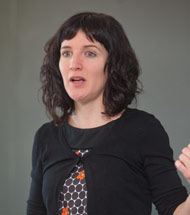A UN consultant gives a lecture on water footprint to students of Master's Degree in Biodiversity.
Maite Aldaya explained how this indicator can be used for a better allocation and management of resources.

PHOTO: Courtesy
"To understand what we should do with water you have to understand how it is used in the first place. You can't manage correctly what you don't measure". This was explained by Maite Aldaya, consultant of the United Nations Environment Program, during her lecture to the students of the Master's Degree in Biodiversity, Landscapes and Sustainable management of the School of Sciences of the University of Navarra.
In his exhibition, he spoke about the water footprint, an indicator of the efficiency and sustainability of water use and management that reflects the appropriation of water resources by human beings. "This includes three components, the blue water footprint, which refers to the consumption of surface and groundwater; the green, that of rainwater consumption; and the gray, which takes into account pollution and is defined as the freshwater required to assimilate a load of pollutants," he clarified.
According to the expert, as consumers"we should know the data water use of households and consumer products because the decisions of someone in Pamplona affect not only the ecosystems of Navarre but also other countries from which their products come". In this sense, an indicator such as the water footprint provides a deeper vision, "it does not tell us what we should do, but rather financial aid us to understand what could be done".
